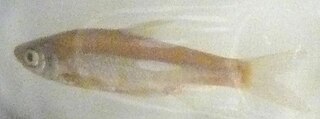
Pseudobarbus is a ray-finned fish genus in the family Cyprinidae. The type species is Burchell's redfin. The scientific name is derived from the Ancient Greek pseudes ("false") and the Latin word barbus. This genus contains some of the South African redfins. It was originally proposed as a subgenus, but has since been found worthy of recognition as a full genus.

Ischikauia is a monospecific genus of freshwater ray-finned fish belonging to the family Xenocyprididae, the East Asian minnows or sharpbellies. The only species in the genus is Ischikauia steenackeri, the wataka, which is endemic to Lake Biwa in Japan. This species was originally described as Opsariichthys steenackeri.
Engraulicypris is a genus of freshwater ray-finned fish belonging to the family Danionidae, the danionins or danios. This genus is classified in the subfamily Chedrinae and the species in the genus are endemic to Africa. In a study of mitochondrial genealogy, the species formerly included in Mesobola are not phylogenetically separated from Engraulicypris and therefore should also be included in Engraulicypris.

Dermatolepis is a genus of marine ray-finned fish, groupers from the subfamily Epinephelinae, part of the family Serranidae, which also includes the anthias and sea basses. They are found in the western Atlantic, Pacific and Indian Oceans.

Limnothrissa is a small genus of freshwater ray-finned fishes elonging to the family Dorosomatidae, which also includes the gizzard shads and sardinellas. The species in this genus are endemic to Africa. It was considered to be monospecific but L. strappersi, a Lake Mweru endemic, has been recognised as a valid species. The Lake Tanganyika sardine was endemic to Lake Tanganyika but has been introduced to Lake Kivu, Lake Kariba and the Cahora Bassa reservoir.

Zacco is a genus of small freshwater ray-finned fishes belonging to the family Xenocyprididae, the East Asian minnows or sharpbellies. They are found in freshwater habitats in China and northern Vietnam. The generic name Zacco derives from the Japanese Zako雑魚.

Hypsibarbus is a genus of cyprinid fish that is found in freshwater in Mainland Southeast Asia, including the Thai-Malay Peninsula.

Heteromormyrus is a genus of freshwater ray-finned fishes belonging to the family Mormyridae, the elephantfishes. These fishes are found in southern and central Africa in Angola, Namibia, the Democratic Republic of the Congo and, maybe, Zimbabwe.

Microthrissa is a genus of freshwater ray-finned fishes belonging to the family Dorosomatidae, which also includes the gizzard shads and sardinellas. The species in this genus are endemic to Africa.

Odaxothrissa, the fangtooth pellonulines, is a genus of fresh-water fish in the family Dorosomatidae. All the extant species in this genus are found in tropical Africa.

Bangana is a genus of fish in the family Cyprinidae, the carps and minnows. It is distributed across much of southern and eastern Asia. Species live mainly in the flowing waters of tropical and subtropical rivers.
Lepidopygopsis is a monospecific genus of freshwater ray-finned fish belonging to the family Cyprinidae, which includes the carps, barbs and related fishes. The only species in the genus is the peninsular hill trout, a species endmeic to India, weher it is restricted to the Periyar and lake in Kerala. The International Union for Conservation of Nature classifies this species as Endangered stating that it is threatened by invasive fish species, pollution and a dam.

Leptocypris is a genus of freshwater ray-finned fishes belonging to the family Danionidae, the danios or danionins. The fishes in this genus are found in Africa
Pseudohemiculter is a genus of freshwater ray-finned fish belonging to the family Xenocyprididae, the East Asian minnows or sharpbellies. The four species in this genus are found in eastern Asia.
Xenobarbus is a monospecific genus of freshwater ray-fiined fish belonging to the family Cyprinidae. the family which includes the carps, barbs and related fishes. The only species in the genus is Xenobarbus loveridgei which is endemic to Tanzania where it is found in Lake Victoria. The species is rare and only known from a few specimens.

The Lake Turkana sardine is an African species of freshwater ray-finned fish belonging to the family Danionidae. It is found in the Nile River and Webi Shebeli, and in the Niger, Bénoué and Volta basin.
Engraulicypris bredoi is an East African species of freshwater ray-finned fish belonging to the family Danionidae. It is endemic to Lake Albert in Uganda and the Democratic Republic of the Congo. Its natural habitats are rivers, intermittent rivers, freshwater lakes, freshwater marshes, and inland deltas. It is threatened by habitat loss.
The river sardine, or hyphen barb, is an African species of [freshwater ray-finned fish belonging to the family Danionidae. It is found in the Cunene, Okavango, upper Zambezi river systems and east coastal rivers from the Limpopo to the Umfolozi in northern KwaZulu-Natal. It is also known from the middle Luapula in Zambia. Engraulicypris gariepinus is sometimes considered conspecific.
Engraulicypris gariepinus is an African species of [freshwater ray-finned fish belonging to the family Danionidae. It is found in the Orange River below the Augrabies Falls. It is sometimes considered conspecific with the river sardine.
Chedrinae, the troutbarbs, is a subfamily of freshwater ray-finned fishes belonging to the family Danionidae, the danionins or danios. The fishes in thus subfamily are found in Asia and Africa.












